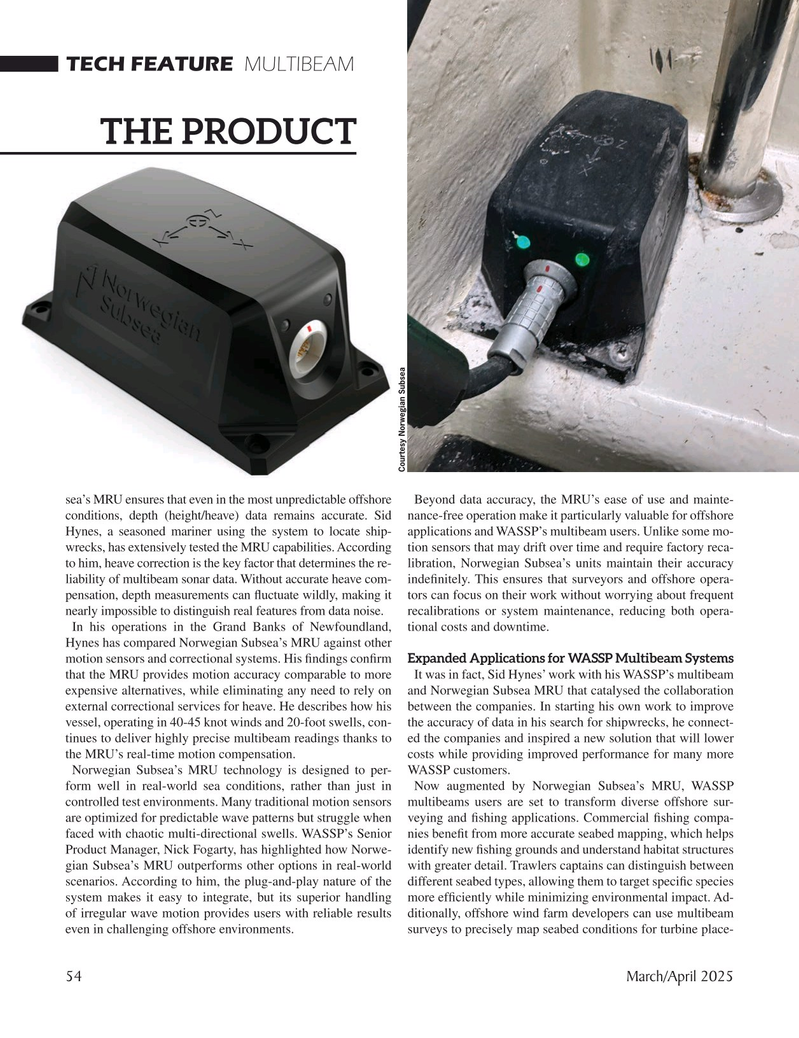
Page 54: of Marine Technology Magazine (March 2025)
Read this page in Pdf, Flash or Html5 edition of March 2025 Marine Technology Magazine
TECH FEATURE MULTIBEAM
THE PRODUCT
Courtesy Norwegian Subsea sea’s MRU ensures that even in the most unpredictable offshore Beyond data accuracy, the MRU’s ease of use and mainte- conditions, depth (height/heave) data remains accurate. Sid nance-free operation make it particularly valuable for offshore
Hynes, a seasoned mariner using the system to locate ship- applications and WASSP’s multibeam users. Unlike some mo- wrecks, has extensively tested the MRU capabilities. According tion sensors that may drift over time and require factory reca- to him, heave correction is the key factor that determines the re- libration, Norwegian Subsea’s units maintain their accuracy liability of multibeam sonar data. Without accurate heave com- inde? nitely. This ensures that surveyors and offshore opera- pensation, depth measurements can ? uctuate wildly, making it tors can focus on their work without worrying about frequent nearly impossible to distinguish real features from data noise. recalibrations or system maintenance, reducing both opera-
In his operations in the Grand Banks of Newfoundland, tional costs and downtime.
Hynes has compared Norwegian Subsea’s MRU against other motion sensors and correctional systems. His ? ndings con? rm Expanded Applications for WASSP Multibeam Systems that the MRU provides motion accuracy comparable to more It was in fact, Sid Hynes’ work with his WASSP’s multibeam expensive alternatives, while eliminating any need to rely on and Norwegian Subsea MRU that catalysed the collaboration external correctional services for heave. He describes how his between the companies. In starting his own work to improve vessel, operating in 40-45 knot winds and 20-foot swells, con- the accuracy of data in his search for shipwrecks, he connect- tinues to deliver highly precise multibeam readings thanks to ed the companies and inspired a new solution that will lower the MRU’s real-time motion compensation. costs while providing improved performance for many more
Norwegian Subsea’s MRU technology is designed to per- WASSP customers.
form well in real-world sea conditions, rather than just in Now augmented by Norwegian Subsea’s MRU, WASSP controlled test environments. Many traditional motion sensors multibeams users are set to transform diverse offshore sur- are optimized for predictable wave patterns but struggle when veying and ? shing applications. Commercial ? shing compa- faced with chaotic multi-directional swells. WASSP’s Senior nies bene? t from more accurate seabed mapping, which helps
Product Manager, Nick Fogarty, has highlighted how Norwe- identify new ? shing grounds and understand habitat structures gian Subsea’s MRU outperforms other options in real-world with greater detail. Trawlers captains can distinguish between scenarios. According to him, the plug-and-play nature of the different seabed types, allowing them to target speci? c species system makes it easy to integrate, but its superior handling more ef? ciently while minimizing environmental impact. Ad- of irregular wave motion provides users with reliable results ditionally, offshore wind farm developers can use multibeam even in challenging offshore environments. surveys to precisely map seabed conditions for turbine place- 54 March/April 2025
MTR #3 (50-63).indd 54 3/14/2025 10:20:13 AM

 53
53

 55
55
